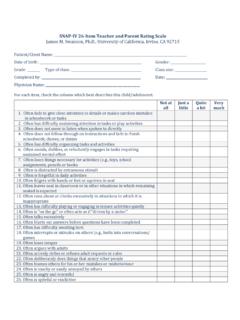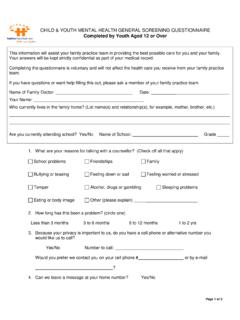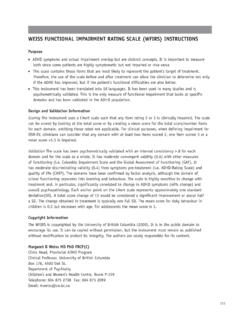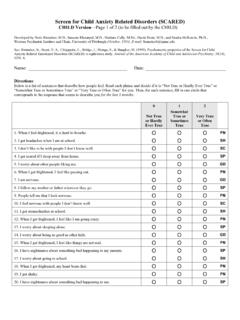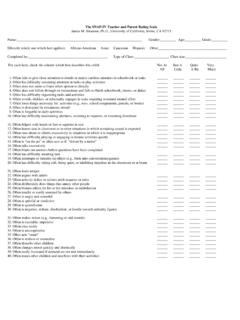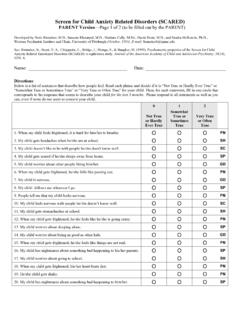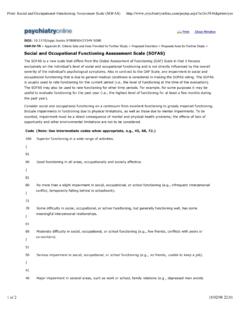Transcription of Kutcher Generalised Social Anxiety Disorder Scale for ...
1 Kutcher Generalized Social Anxiety Disorder Scale for Adolescents (K-GSADS-A) Section A: Fear and Avoidance Scoring: 0 = Never; 1 = Mild; 2 = Moderate; 3 = Severe/Total Avoidance Item Discomfort, Anxiety , Distress (0-3) Avoidance (0-3) 1 Initiating conversation with a member of the opposite sex 2 Attending a party or other Social gathering with people you don't know very well 3 Speaking up, answering questions in class/participating in class discussions 4 Presenting in front of a small group or in a classroom setting 5 Attending overnight group activities such as camps, school trips, etc. 6 Speaking to a store clerk, bank teller, etc. 7 Asking a stranger for directions 8 Changing in a common locker room 9 Showering in a common shower room 10 Using a public toilet facility or urinating in public (score whatever is greater) 11 Telephoning to ask for information or to speak to someone you don't know very well (score whatever is greater) 12 Entering a classroom or Social group once the class or activity is already underway 13 Initiating conversation with strangers 14 Speaking with authority figures: teachers, counselor, principal, police officers, clergy, physician, etc.
2 15 Eating in public 16 Going to a party alone 17 Asking someone for a date 18 Writing your name in public Copyright 1999 Stan Kutcher Version 4 Section B: Fear/Avoidance - Seminal Items What are your three most feared Social situations and how strong is the fear/avoidance of each Scoring: 0 = Never; 1 = Mild; 2 = Moderate; 3 = Severe/Total Avoidance Fear Avoidance (0-3) 1 2 3 Section C: Distress Quotient In general, how strongly do these items occur to you in most Social situations? Scoring: 0 = Never; 1 = Mild; 2 = Moderate; 3 = Severe/Total Avoidance Item Score (0 - 3) 1 Feeling embarrassed or humiliated 2 Feeling 'centered out', scrutinized by others 3 Feeling judged or critically evaluated by others 4 Wanting to leave the Social situation 5 Anxious anticipation of Social situation 6 Experiences a panic attack 7 Blushes 8 Sweats or hot/cold flashes 9 Urination urges 10 Gastrointestinal distress 11 Trembling or shaking Subscale scores and Total Score: SS1: Fear and Anxiety Score (Items A 1-18, Anxiety column) SS2: Avoidance Score (Items A 1-18, avoidance column) SS3: Affective Distress Score (Items C 1-5) SS4: Somatic Distress Score (Items C 6-11) Total K-GSADS-A Score (SS1 + SS2 + SS3 + SS4) Interpretation of scores: There are no validated diagnostic categories associated with particular ranges of scores.
3 All scores should be assessed relative to an individual patient's baseline score (higher scores indicating worsening Social phobia, lower scores suggesting possible improvement). Copyright 1999 Stan Kutcher Version 4 The Kutcher Generalized Social Anxiety DisorderScale for Adolescents: assessment of its EvaluativeProperties Over the Course of a 16-Week PediatricPsychopharmacotherapy TrialSarah J. Brooks, ,1and Stan Kutcher , , FRSPC1 ABSTRACTO bjective:This study investigated the psychometric properties of a new clinician-rated scaledesigned to assess the severity of Social phobia and measure treatment outcome in adoles-cents: the Kutcher Generalized Social Anxiety Disorder Scale for Adolescents (K-GSADS-A).Methods:Two hundred fifty-one (251) adolescents (11 17 years; mean age years) withDSM-IV Social phobia enrolled in a multicenter, 16-week, double-blind, placebo-controlledstudy of paroxetine. Efficacy assessments were conducted at baseline and at weeks 4, 8, 12,and 16 with the K-GSADS-A, three other clinician-rated scales (including the Clinical GlobalImpression of Severity Scale ), and a self-rated Social phobia Scale .
4 Additionally, the ClinicalGlobal Impression of Improvement Scale was administered at each postbaseline assessment ,and the Children s Depression Rating Scale Revised was administered at baseline and atweek 16. These data were used to assess the internal consistency, convergent and divergentvalidity, and sensitivity to change of the :The internal consistency of the K-GSADS-A was adequate, and supportive evi-dence was obtained for its convergent validity with other severity measures, and its diver-gent validity with respect to depression. The K-GSADS-A also demonstrated goodsensitivity to changes in :These results suggest that the K-GSADS-A is a valid measure of treatmentoutcome in adolescents with DSM-IV Social OF CHILD AND ADOLESCENT PSYCHOPHARMACOLOGYV olume 14, Number 2, 2004 Mary Ann Liebert, 273 2861 Department of Psychiatry, Dalhousie University, Halifax, Nova Scotia, work was supported, in part, by a contract from GlaxoSmithKline Pharmaceuticals and by the DesignatedMental Health Research Fund Province of Nova Scotia, PHOBIA( , Social Anxiety Disorder )is a common psychiatric Disorder involv-ing substantial comorbidity with other anxi-ety and personality disorders (Hazen andStein 1995).
5 Social phobia is also associatedwith financial dependency and elevated ratesof suicide (Schneier et al. 1992). Lifetimeprevalence rates are as high as 13% (Ander-son et al. 1987; Magee et al. 1996), and thedisorder most commonly onsets in mid-ado-lescence (Schneier et al. 1992). During adoles-cence, the Disorder has been shown to have anegative impact on academic achievement(Francis and Radka 1995), and to be 7/7/04 3:30 PM Page 273ated with an increased risk of alcohol abuse(Clark and Sayette 1993).Recent years have witnessed a surge in clini-cal treatment studies for pediatric Anxiety dis-order, including Social phobia ( , Compton etal. 2001; Pine et al. 2001; Silverman et al. 1999).The success of such studies depends on the abil-ity of investigators to accurately measure theseverity of target symptoms over time. While afew self-rated scales for assessing Social anxietyseverity have been shown to have validity inadolescent samples for example, the SocialPhobia Anxiety Inventory (Turner et al.)
6 1989)and the Social Anxiety Scale for Adolescents (LaGreca and Lopez 1998) there is a dearth ofclinician-rated tools designed for this purpose(Brooks and Kutcher 2003).One recently developed clinician-rated toolfor assessing symptoms of Anxiety in young-sters (6 17 years) is the Pediatric Anxiety Rat-ing Scale (PARS; Riddle et al. 2002). It appearsto have promising psychometric properties forindexing the overall severity of symptoms ofanxiety disorders , including symptoms of gen-eralized Anxiety Disorder , Social phobia, sepa-ration Anxiety Disorder , and specific , neither its total score nor any of itscomponent summary scores are specific tosymptoms of Social instrument tested in this study theKutcher Generalized Social Anxiety DisorderScale for Adolescents (K-GSADS-A) was de-signed specifically to serve as a measure oftreatment outcome for adolescents with socialphobia. At the time of its initial development(during 1999), the authors were aware of noother clinician-rated tools being available forassessing the severity of Social phobia in eitherchildren or Scale can be administered without spe-cific training by clinicians who have recog-nized competency in child and adolescenthealth, and who are knowledgeable about so-cial phobia.
7 Physicians, Social workers, andnurses who have experience with socially anx-ious adolescents would be suitable adminis-trators, as well as mental health aim of this study was to evaluate thepsychometric properties of the K-GSADS-A ina clinical sample of adolescents. We examinedthe internal consistency, test-retest reliability,convergent and divergent validity, and sensi-tivity to change of the K-GSADS-A in a sampleof 251 adolescents, who enrolled in a 16-week,randomized, double-blind, placebo-controlledtrial of paroxetine as a treatment for socialphobia in children and adolescents. Paroxetinewas established as an effective treatment inthis pediatric sample (8 17 years; n = 319; Di-neen Wagner et al. 2002). We also examinedwhether there were significant gender- and/orage-related differences among the responses toK-GSADS-A items in our clinical adolescentsample. Finally, we examined the similaritiesand differences between the K-GSADS-Aand the Liebowitz Social Anxiety Scale forChildren and Adolescents (LSAS-CA; Masia-Warner et al.)
8 2003) another clinician-ratedscale for assessing pediatric Social phobia,which was developed by other authors at thesame time as the sample consisted of 251 adolescents(aged 11 17 years) who participated in aninternational multicenter, 16-week, random-ized, double-blind, placebo-controlled study toevaluate the safety and efficacy of paroxetinein children and adolescents (aged 8 17 years)with DSM-IV Social phobia. In this study,paroxetine was demonstrated to be an effec-tive treatment for Social phobia in this agegroup (Dineen Wagner et al. 2002), thus allow-ing for appropriate evaluation of the proper-ties of the K-GSADS-A. Thirty-eight (38)centers contributed adolescent subjects to thestudy: 22 in the USA, 10 in South Africa, 4 inCanada, and 2 in Belgium. The number of ado-lescent subjects per center ranged from 1 to 16(mean = ; standard deviation = ). At en-rollment, all subjects met the DSM-IV criteriafor a primary diagnosis of Social phobia, asconfirmed by the DSM-IV version of the Anxi-ety disorders Interview Schedule for Children(ADIS-C/P; Silverman and Albano 1996).
9 Ex-clusion criteria precluded the participation ofpatients who were judged to have a clinicallypredominant Axis I Disorder other than socialphobia, concurrent major depression, or anyhistory of psychosis, bipolar Disorder , or per-274 BROOKS ET 7/7/04 3:30 PM Page 274vasive developmental Disorder . Patients con-sidered to be at-risk for suicide or homicide,and patients with a history of substance abuseor dependence within the preceding 3 months,were also excluded. Other grounds for exclu-sion were concurrent psychotherapy and/orthe concurrent use of psychoactive trial investigators felt that because ofthe chronic nature of Social phobia, a standard8- to 10-week design would not be adequatefor this population. Subjects who were re-sponding poorly to treatment with eitherparoxetine or a placebo could withdraw fromthe study at any time and be provided with analternative were scheduled to be assessedwith the K-GSADS-A (and other instruments)on five occasions at baseline and on foursubsequent occasions; wherever possible, thesame clinician (psychiatrist, clinical psychol-ogist, or psychometrician with a minimum of2 years of experience with pediatric patients)conducted all the assessments.
10 Relative to thestart of the paroxetine/placebo treatment, thefour postbaseline assessments were sched-uled for weeks 4, 8, 12, and 16. On each ofthese occasions, in the clinician s chosenorder, subjects were rated on the K-GSADS-A, the global assessment of functioning (GAF) Scale , the Clinical global Impression ofSeverity (CGI-S; Guy 1976) Scale and theLSAS-CA. All subjects were additionally as-sessed on the Clinical global Impression ofImprovement (CGI-I; Guy 1976) Scale at eachpostbaseline assessment , and with the Chil-dren s Depression Rating Scale Revised(CDRS-R; Poznanski et al. 1985) at baselineand week 16. Subjects aged 11 13 years com-pleted the self-rated Social Phobia and Anxi-ety Inventory for Children (SPAI-C; n = 91),while those aged 14 17 completed the self-rated Social Phobia and Anxiety Inventory(SPAI; n = 160).Clinicians in centers in Belgium and SouthAfrica were responsible for translating (and/or paraphrasing) the items of English-lan-guage copies of the various clinician-ratedscales, including the K-GSADS-A, into thelocal language appropriate for their subjects( French, Dutch, or African).
